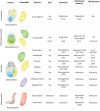Modes and mechanisms for the inheritance of mitochondria and plastids in pathogenic protists
- PMID: 39847585
- PMCID: PMC11756805
- DOI: 10.1371/journal.ppat.1012835
Modes and mechanisms for the inheritance of mitochondria and plastids in pathogenic protists
Abstract
Pathogenic protists are responsible for many diseases that significantly impact human and animal health across the globe. Almost all protists possess mitochondria or mitochondrion-related organelles, and many contain plastids. These endosymbiotic organelles are crucial to survival and provide well-validated and widely utilised drug targets in parasitic protists such as Plasmodium and Toxoplasma. However, mutations within the organellar genomes of mitochondria and plastids can lead to drug resistance. Such mutations ultimately challenge our ability to control and eradicate the diseases caused by these pathogenic protists. Therefore, it is important to understand how organellar genomes, and the resistance mutations encoded within them, are inherited during protist sexual reproduction and how this may impact the spread of drug resistance and future therapeutic approaches to target these organelles. In this review, we detail what is known about mitochondrial and plastid inheritance during sexual reproduction across different pathogenic protists, often turning to their better studied, nonpathogenic relatives for insight.
Copyright: © 2025 Collier et al. This is an open access article distributed under the terms of the Creative Commons Attribution License, which permits unrestricted use, distribution, and reproduction in any medium, provided the original author and source are credited.
Conflict of interest statement
The authors have declared that no competing interests exist.
Figures





References
-
- McFadden GI. Primary and secondary endosymbiosis and the origin of plastids. J Phycol. 2001;37:951–959. doi: 10.1046/j.1529-8817.2001.01126.x - DOI
Publication types
MeSH terms
LinkOut - more resources
Full Text Sources

